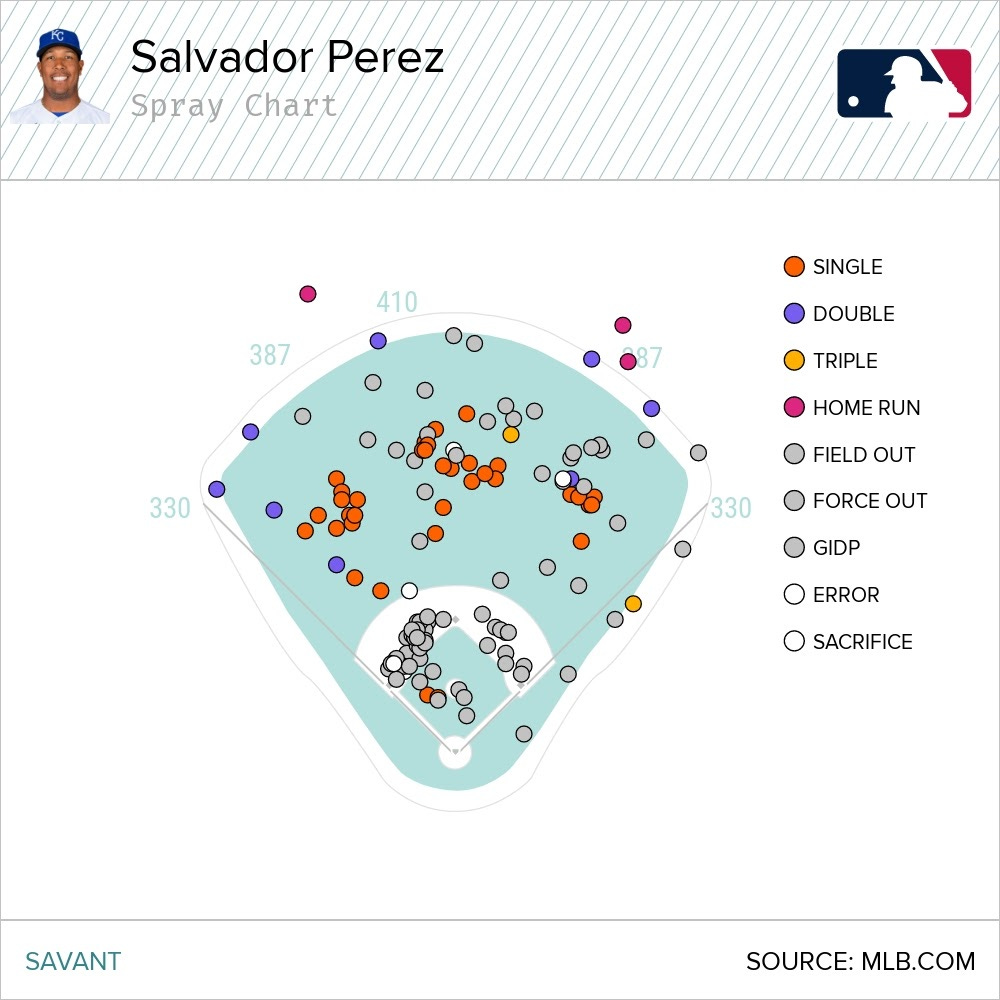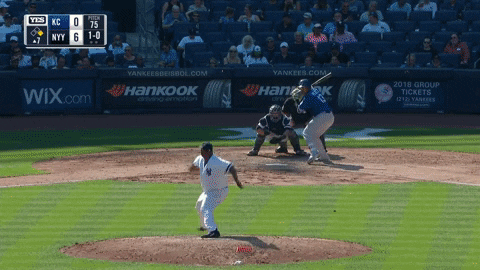Salvador Perez and the Fight to Repeat
Can he turn his great 2020 into a second half of his career that puts him on track to Cooperstown?
When Salvador Perez burst onto the scene in August of 2011, he was a breath of fresh air. He had fun on the field, but watching him hit was actually pretty fun too if you could get past the swinging at everything. He was awesome at the plate, hitting .331/.361/.473 in 158 plate appearances to end that season. You can see the spray chart. He was hitting it all over the field, and more importantly, driving it all over the field.
Over time, the numbers declined. His next year, which started late due to a knee injury, he hit .301/.328/.471. He still didn’t walk, but he basically never struck out and hardly even swung and missed. It was actually a heck of a season, but still the numbers weren’t quite as good as the short rookie season. He was still good in 2013, but not as good. The swinging strike rate crept up, the average crept down and the power went with it. The real decline started in 2014, though.
While his ISO in 2013 dipped back to 2011 levels, the average was still high enough to sustain his OBP and SLG. In 2014, that was no longer the case. His average dropped to .260, so he had his first of five straight sub-.300 OBP seasons. With his ISO staying in the .140ish range, his slugging percentage fell to what is still a career low. This isn’t my theory, but I believe the workload was starting to get to him. But the good news is that he was able to incorporate more power back in his game and while his ISO rose the next three seasons, so did his whiff rate and strikeout rate while his walk rate remained the same.
Anyway, fast forward to 2020 and he had his best offensive season since his rookie year. Is it a coincidence that it was another 150ish plate appearance season? Probably not. But he did miss all of 2019, as you know, with Tommy John surgery and thus had some time to finally rest up. That, combined with only playing 60 team games all year, might have been just what he needed to get his career back on track and headed in a direction that some think could end in Cooperstown (spoiler alert - I don’t see it).
Are you enjoying this article but haven’t yet subscribed? You can do it right now!
Let’s take a look at what changed in 2020 to see if he can carry it forward in 2021. Here’s his spray chart to compare to 2011.
It’s not quite the array of spray that we saw back in 2011, but he was driving the ball to right field much more than we’d seen in the interim seasons. The numbers show that he actually went opposite field less than in every season but one since 2015 but that he pulled the ball less as well, which I think was getting him in some trouble.
What else was different?
Batted Ball Quality
Salvador Perez was working with Mike Tosar, just like Jorge Soler did before his breakout 2019, but this was actually something that had been increasing in previous seasons. His barrel percentage in 2020 was 13.9 percent, up from 10.8 percent in 2018, 9.4 percent in 2017, 6.3 percent in 2016 and 5.3 percent in 2015. That’s a pretty solid trajectory. His hard hit percentage was also considerably higher in 2020 than it had been in every season before 2018. Average exit velocity tells the same story.
There were two areas that sort of go hand in hand that jumped out in 2020, though, and that was both his average launch angle and his sweet spot percentage. The angle dropped down to 14.2° after being above 18 for the last three seasons he played. With less of the high, arching contact, his sweet spot percentage jumped from the mid-30s to 41.7 percent. That tells a big chunk of the story.
Contact
You might be wondering why this isn’t under the batted ball category and it’s because I’m about to throw you a curve, similar to ones that Salvy swings and misses at often. He made less contact in 2020. It was less contact on pitches both in and out of the strike zone. His whiff percentage was still just slightly worse than the league average but also the worst of his last five seasons by a full three percent over his previous worst.
And yet, I think this is a good thing. Sometimes making contact on pitches that pitchers want hitters to swing at can lead to weak contact. By actually making less contact, the quality of said contact was better. It seems bizarre, but the logic is there.
Fastballs
I suppose some of this could go in the batted ball category, but the numbers are pretty crazy, so they go in their own area. Perez hit .426 with a slugging percentage of .853 in 2020 on fastballs. And it’s not like he was especially fluky. Sure, a little, but his xBA was .370 and his xSLG was .759. All the stats were the best he’s ever put up against fastballs, and he’s been good against fastballs in the past. Pitchers even started to wise up and threw him fewer fastballs than ever before, but he did so much damage that he was able to boost his overall numbers against fastballs alone.
His Stance
I’ll let video show you the bulk, but Perez opened up in 2020. If you look at the gif below against the Yankees, he was in a pretty straight line stance, but in the video against the Tigers you see his left leg probably a good 20° toward third base. I think that does a lot of work for him, allowing to see the ball longer and attack what he and Tosar worked on prior to the season. The pitches are pretty similar and while the results were great on both, it does seem like going with that pitch where he did against Tarik Skubal is more sustainable than what he did against CC Sabathia.
2017:
2020:
Is the whole thing sustainable? Well no, probably not. A sample of 156 plate appearances isn’t really enough to think that he’s suddenly back to being the hitter for average he was early in his career with the power he’s picked up later. We may have seen some of the correction starting before the season even ended (though it was also just three tough games, so maybe not). But I do think that the quality of contact coupled with the ability to pick out pitches to drive that might come from his stance allowing him better sight is something that can continue.
The rest he had by not playing in 2019 and a short season in 2020 helped quite a bit as well, so I hope Mike Matheny goes against every instinct he has and gives him some time off. Cam Gallagher is a perfectly capable backup, both with the bat and with the glove. It’s a downgrade, but to avoid the second half swoon that we see from Perez in full seasons, it’s a downgrade a couple times a week that’s totally worth it because I think a lot of the gains Perez made in 2020 can move forward. I’m not counting on .330/.360/.630, but something around .270/.300/.530 is possible and would be huge in the middle of this lineup.







